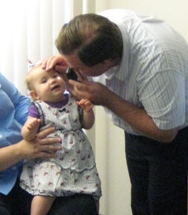|
|
|
Children are usually born with fairly clear eyesight, but not vision.
With vision, we understand what we see, where things are, and we are able to compare what we see with our other senses.
Vision is learned over time. When a child is born, the child goes through many steps to master critical visual skills.
The purpose of a vision evaluation is to look at a child’s visual skills, to evaluate whether they are performing at their age level, and to go over what types of visual demands the child is facing.
|
|
A child’s vision development is critical in determining how he or she will meet life’s demands. Vision problems are a leading source of learning and academic difficulties. Many of these vision problems can be detected and corrected long before they interfere with a child’s academic performance.
Many of these vision problems are related to nearpoint stress and are undetected by a school nurse or pediatrician. Early intervention is very important.
| |
 |
|
An optometrist trained in working with a child can assess many important things about their vision. The doctor can check to be sure that both eyes are seeing equally well. This is not something that a parent can tell by observing, nor is it something that the pediatrician can measure. It requires using a retinoscope to assess where and how well each eye is focusing on a target. There are devices that can also measure the child’s eyesight without the child saying anything.
In addition the doctor needs to evaluate the child’s eye movement (tracking) skills, the child’s ability to use the eyes together (binocularity), the ability to keep the eyes aligned as a target is moved inwards (convergence), the child’s ability to guide their hands to find a target, their balance, and their ability to move their eyes back and forth across the midline of their body. The doctor can evaluate the child’s ability to change their focus from one target to another. These skill are all essential skills for success in school, sports and life in general.
Most importantly, the doctor can make sure that both eyes are healthy. It takes very special training to assess the internal health of an infant or small child. Sometimes that training can detect a very serious eye disease or illness when it is most easily treated.
When to bring a child in for an exam?
We like to begin seeing a child before their first birthday. In fact the doctors at Family Optometry belong to a national program called Infantsee. This program provides a full vision evaluation to any child up to one year of age at no charge. When you are making an appointment please mention this program. The second eye exam should be around 2.5 years of age and the third exam should be just before first grade. The child should have received three eye exams before starting first grade.
|
|
|